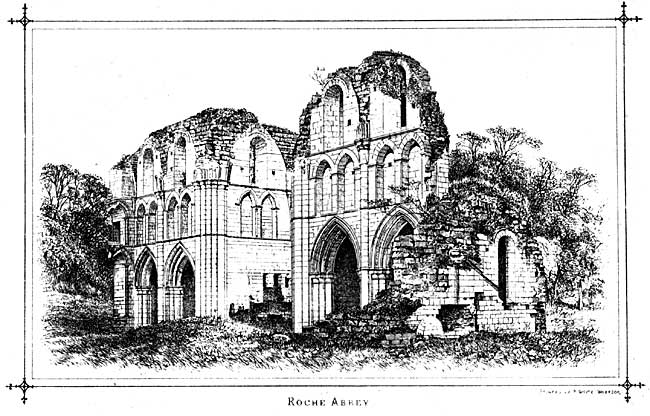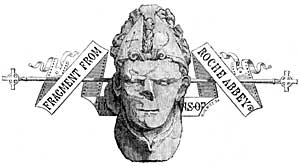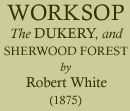< Previous | Contents | Next >
Roche Abbey

Roche Abbey is about nine miles north-west of Worksop. The remains are those of a Cistercian abbey, dedicated, as was the custom of that order, to the Blessed Virgin. The original monks came from the abbey of Newminster, near Morpeth, which was an off-shoot from Fountains Abbey.
The Abbey was founded in 1147 by Richard de Busli and Richard Fitz Turgis, the owners of the soil on either side of the stream, upon which the "Monks of the rock" had settled. The monks also received numerous benefactions from other persons, among whom were King Henry II. Idonea de Vipont granddaughter of Richard de Busli the co-founder, who, with her body granted them the manor of Sandbeck; Edmund de Laci, constable of Chester; and William, the sixth Earl of Warren, the latter of whom granted them the tenth of the residue of the eels taken out of the fisheries in Hatfield, Thorne, and Fishlake after the deduction of the full tithes which belonged to the monks of Lewes; while in William, the last Earl of Warren, they found a still larger benefactor, who, "grieving for the paucity of the monks serving God there, gave for the support of thirteen additional monks the advowson of the church of Hadfield, then valued at seventy marks per annum." Leo de Maunvers gave them Brancliffe, Ralf de Fortemayn lands in Todwick, and Robert, the son of Glai, of the family who built the chapel at Steetley, land and a wood at Conisborough. Alicea, Countess of Eu, the great lady of the manor of Tickhill, confirmed all the gifts of her tenants. The abbey also received confirmation charters from Kings Richard I. and Henry III.; and Pope Urban the third, by his Bull dated in 1186, confirmed the then made and all future donations, and exempted the abbot and monks from payment of tithes for all lands in their own occupation.In 1446 Roche Abbey obtained another benefactor in Matilda, Countess of Cambridge, who with her body (which she ordered to be buried at Roche in the chapel of the Blessed Virgin in the southern part of the church) gave xlii. marks for three chaplains to pray for her soul, also a white vestment and a penny a day to a monk for the same purpose, also vis viiid. to the abbot, and xxd. to each monk on the day of her burial; also xl. marks to celebrate once in each year her obit, also her whole vestment of red colour worked with gold, with one chalice, two cruets, two best silver candlesticks, and one silver bell, to remain with her body, for the use of the church of Rochc. This Matilda was daughter of Thomas de Clifford, and it is on account of this relationship that Henry Clifford, Earl of Cumberland, was returned in the "visitation" of Leigh and Layton as the founder of Roche. In this same "visitation" serious charges were made against five of the monks; John Robinson, a monk, is suspected of treason and imprisoned at York, and it is also complained of that pilgrimage is made to an image of the crucifix, found as it is believed on a rock, and held in great veneration.
In 1538, June 23, the year after the above visitation, the abbey was surrendered by the abbot and seventeen monks; shortly after which the church and other buildings were given to destruction. Some few remains of these, however, still exist, and these are of great interest and beauty. They principally consist of portions of the eastern part of the church, bases of the central tower, and of some of the piers of the nave, with the basement of the west end. The church has been cruciform, having a short choir with two chapels on each side, transepts without aisles, and a nave, with arcades of eight arches opening into aisles; the whole length having been about two hundred feet, while that of the transepts was about one hundred feet. A faint idea may be obtained of what must have been the beauty of the whole structure from the principal remains already alluded to, namely, the eastern arcades of the transepts. Here we have on each side the choir two well-proportioned pointed arches, resting upon clustered columns, with plain capitals. Above these, on a string, two blank pointed arches in each compartment; and over these, separated by another string, a single round-headed window. The springers of the vaulting still remain, which arise from bold clustered shafts. The choir arch is gone, but it has been a very lofty and noble one; and of the choir itself only the south and north sides remain, in the former of which is a large round arch, which has contained sedilia, and to the east of this an aperture, which has held a piscina and a lockyer. On the north side are the traces of some rich tabernacle work, probably the remains of the tomb of some great bene factor. The chapels on the south side are entire; they are groined. Those on the north much ruined. The architecture of these remains indicate the end of the 12th century as the time of the erection of the church.
The principal offices of the abbey surrounded a cloister court on the south side of the nave of the church; of these nothing remains but a fragment or two. No doubt they followed the usual arrangement of a Cistercian Abbey, having on the eastern side next the south transept—first, a vestry; next, the chapter house; then, probably, another small apartment; after that a passage, having to the south of it the monks' parlour. Over these would be the dormitory of the monks, from which a staircase would lead into the church. On the south side of the court would be the kitchen, the refectory, and the buttery; on the west a large undercroft, as at Fountains and Kirkstall, and other places, which has served as a storehouse; and over this the dormitory of the Conversi, or lay brethren. It is probable that the guest house was at the southern end of this building, and also the abbot's residence.
The Infirmary was most likely to the south-east of this cloister court; and here, too, separated by the stream, are the remains of the abbey mill.
At some distance to the north-west arc the remains of the Gatehouse, of which the lower parts are pretty entire. It is entered on both sides by obtusely pointed arches, resting on clustered shafts, and in the middle has a principal and postern arch, each compartment being groined over with bold ribs resting on plain brackets.These are the only remains of any consequence of this once magnificent abbey; still, not only for their own sake, but because of the delightfully secluded scenery in which they are situated, presenting as it does an exquisitie combination of hill, wood, and water, they form a most charming object to the visitor; and by the liberality of the noble owner, the Earl of Scarborough, are open to the public on Mondays and Thursdays in each week.

